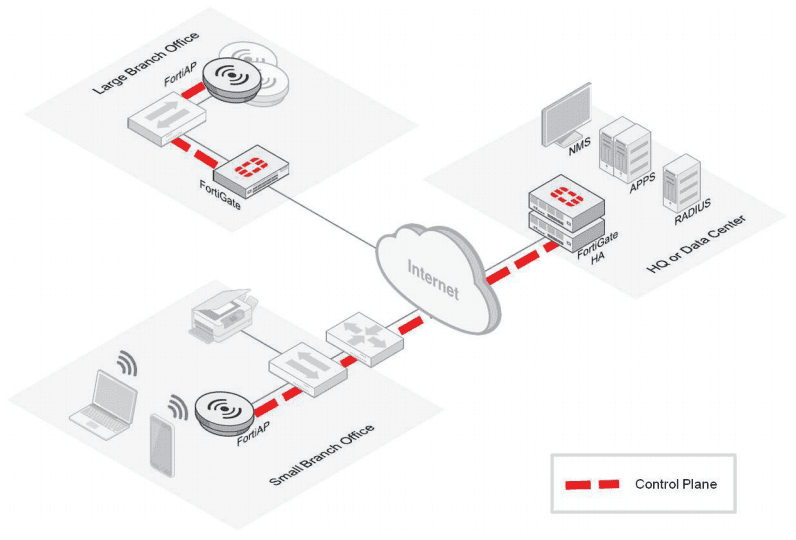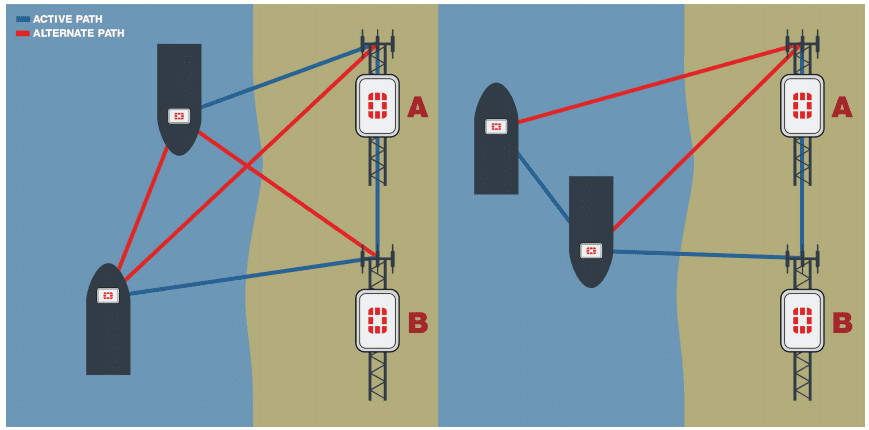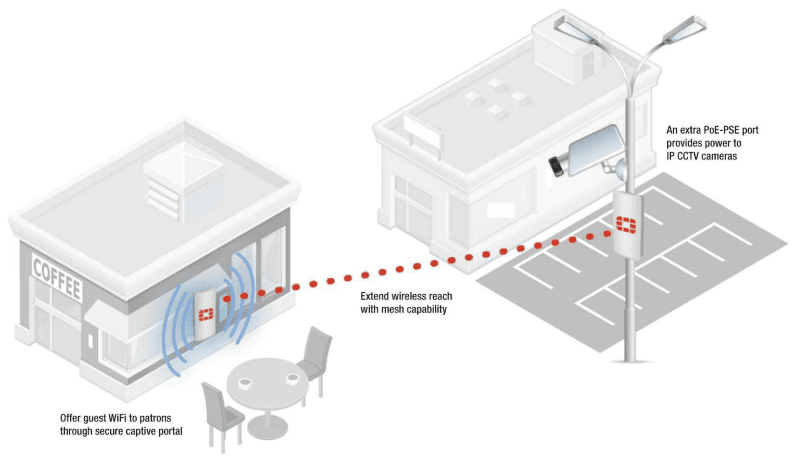Email: [email protected] Ligue agora! +55-11-3717-5537
The FortiAP 321C is a dual-radio 802.11ac AP, designed for medium density indoor environments, including hotspot and guest or social WiFi deployments. The smoke detector form factor is perfect where discreet installation is required, like school classrooms and retail stores.
FortiAP access points are managed centrally by the integrated WLAN controller of any FortiGate® security appliance or can be managed through the free FortiCloud provisioning and management portal. With the integration of the wireless controller functionality into the market leading FortiGate appliance, Fortinet delivers a true Unified Access Layer. This enables you to easily manage wired and wireless security from a Single-pane-of-glass management console and protects your network from the latest security threats.
Unified Management
Unified management console simplifies operations, ensuring consistent and effective policy enforcement and compliance.
Advanced Security Protection
Wireless LAN security done right, from the leader in network security. Integrated Firewall, IPS, Application Control, and Web Filtering protect the wireless LAN from the latest security threats.
Built-in WiFi Security
Protects the network from advanced wireless threats and satisfies PCI DSS compliance.



| FortiAP-321C | |
|---|---|
| Hardware | |
| Indoor/Outdoor Deployment | Indoor AP |
| Number of Radios | 2 |
| Number of Antennas | 6 Internal |
| Antenna Type and Peak Gain | PIFA: 4 dBi for 2.4 GHz, 5 dBi for 5 GHz |
| Frequency Bands (GHz)* | 2.400–2.4835, 5.150–5.250, 5.250–5.350, 5.470–5.725, 5.725–5.850 |
| Radio 1 Capabilities | 2.4 GHz b/g/n (3×3:3 stream) 20/40 MHz (64 QAM) |
| Radio 2 Capabilities | 5 GHz a/n/ac (3×3:3 stream) 20/40/80 MHz (256 QAM) |
| Maximum Data Rate | Radio 1: Up to 450 Mbps Radio 2: Up to 1300 Mbps |
| Bluetooth Low Energy (BT/BLE) Radio | — |
| Interfaces | 1x 10/100/1000 Base-T RJ45 |
| Power over Ethernet (PoE) | IEEE 802.3af |
| Simultaneous SSIDs | Up to 16 (14 if background scanning enabled) |
| EAP Type(s) | EAP-TLS, EAP-TTLS/MSCHAPv2, EAPv0/EAP-MSCHAPv2, PEAPv1/EAP-GTC, EAP-SIM, EAP-AKA, EAP-FAST |
| User/Device Authentication | WPA and WPA2 with 802.1x or Preshared key, WEP, Web Captive Portal, MAC blacklist & whitelist |
| Maximum Tx Power | 2.4 GHz: 24 dBm / 251 mW (3 chains combined)* 5 GHz: 25 dBm / 316 mW (3 chains combined)* |
| Kensington Lock | Yes |
| IEEE Standards | 802.11a, 802.11b, 802.11e, 802.11g, 802.11h, 802.11i, 802.11j, 802.11k, 802.11n, 802.11r, 802.11v, 802.11ac, 802.1X, 802.3af |
| SSID Types Supported | Local-Bridge, Tunnel, Mesh |
| Per Radio Client Capacity | Up to 128 |
| Cellular Co-existence | No |
| LED Off Mode | Yes |
| Advanced 802.11 Features | |
| 802.11ac Wave 2 MU-MIMO | No |
| Transmit Beam Forming (TxBF) | No |
| Low-Density Parity Check (LDPC) Encoding | Yes |
| Maximum Likelihood Demodulation (MLD) | Yes |
| Maximum Ratio Combining (MRC) | Yes |
| A-MPDU and A-MSDU Packet Aggregation | Yes |
| MIMO Power Save | Yes |
| Short Guard Interval | Yes |
| Wireless Monitoring Capabilities | |
| Rogue Scan Radio Modes | Background, Full-time |
| WIPS / WIDS Radio Modes | Background, Full-time |
| Packet Sniffer Mode | Yes |
| Spectrum Analyzer | Yes |
| Dimensions | |
| Length x Width x Height | 6.3 x 6.3 x 1.66 inches (160 x 160 x 42 mm) |
| Weight | 0.77 lbs (0.35 kg) |
| Package (shipping) Weight | 1.33 lbs (0.6 kg) |
| Mounting Options | Ceiling, T-Rail, and Wall |
| Included Accessories | Mount kits for Ceiling, T-Rail, and Wall |
| Environment | |
| Power Supply | SP-FG20C-PA-XX, GPI-115, or GPI-130 |
| Power Consumption (Max.) | 12.6 W |
| Humidity | 5% to 90% non-condensing |
| Operating Temperature | -32 to 113°F (0–45°C) |
| Storage Temperature | -4 to 140˚F (-20 to 60˚C) |
| Directives | Low Voltage Directive • RoHS2 |
| UL2043 Plenum Material | No |
| Mean Time Between Failures | >30 Years |
| IP Rating | — |
| Surge Protection Built In | — |
| Hit-less PoE Failover | No |
| Certifications | |
| WiFi Alliance Certified | Yes |
| DFS | CE, Japan |
| Certifications | |
| Limited Lifetime Warranty | Yes |
* Frequency selection and power may be restricted to abide by regional regulatory compliance laws.
| FortiAP 321C | ||||
|---|---|---|---|---|
| Radio 1 — 2.4 GHz | Radio 2 — 5 GHz | |||
| 802.11 a/g | Tx Power (dBm) | Rx Sensitivity (dBm) | Tx Power (dBm) | Rx Sensitivity (dBm) |
| 6 Mbps | 24 | -90 | 25 | -93 |
| 9 Mbps | 24 | -90 | 25 | -91 |
| 12 Mbps | 24 | -89 | 25 | -89 |
| 18 Mbps | 24 | -87 | 25 | -87 |
| 24 Mbps | 24 | -84 | 25 | -84 |
| 36 Mbps | 21 | -80 | 28 | -80 |
| 48 Mbps | 21 | -76 | 19 | -78 |
| 54 Mbps | 21 | -75 | 19 | -77 |
| 802.11n HT20 | ||||
| MCS 0/8 | 23 | -90 | 25 | -93 |
| MCS 1/9 | 23 | -87 | 25 | -87 |
| MCS 2/10 | 23 | -85 | 25 | -85 |
| MCS 3/11 | 23 | -82 | 25 | -82 |
| MCS 4/12 | 21 | -78 | 25 | -78 |
| MCS 5/13 | 21 | -76 | 25 | -77 |
| MCS 6/14 | 20 | -75 | 25 | -76 |
| MCS 7/15 | 20 | -74 | 24 | -75 |
| 802.11n HT40 | ||||
| MCS 0/8 | 22 | -87 | 25 | -90 |
| MCS 1/9 | 22 | -84 | 25 | -84 |
| MCS 2/10 | 22 | -82 | 25 | -82 |
| MCS 3/11 | 22 | -79 | 25 | -79 |
| MCS 4/12 | 20 | -75 | 25 | -76 |
| MCS 5/13 | 20 | -73 | 25 | -75 |
| MCS 6/14 | 19 | -72 | 25 | -74 |
| MCS 7/15 | 19 | -71 | 24 | -73 |
| 802.11ac VHT20 | ||||
| MCS 0 | — | — | 25 | -93 |
| MCS 1 | — | — | 25 | -87 |
| MCS 2 | — | — | 25 | -85 |
| MCS 3 | — | — | 25 | -82 |
| MCS 4 | — | — | 25 | -78 |
| MCS 5 | — | — | 25 | -77 |
| MCS 6 | — | — | 25 | -76 |
| MCS 7 | — | — | 24 | -75 |
| MCS 8 | — | — | 23 | -71 |
| 802.11ac VHT40 | ||||
| MCS 0 | — | — | 25 | -90 |
| MCS 1 | — | — | 25 | -84 |
| MCS 2 | — | — | 25 | -82 |
| MCS 3 | — | — | 25 | -79 |
| MCS 4 | — | — | 25 | -76 |
| MCS 5 | — | — | 25 | -75 |
| MCS 6 | — | — | 25 | -74 |
| MCS 7 | — | — | 24 | -73 |
| MCS 8 | — | — | 22 | -67 |
| MCS 9 | — | — | 20 | -65 |
| 802.11ac VHT80 | ||||
| MCS 0 | — | — | 25 | -88 |
| MCS 1 | — | — | 25 | -81 |
| MCS 2 | — | — | 25 | -79 |
| MCS 3 | — | — | 25 | -76 |
| MCS 4 | — | — | 25 | -72 |
| MCS 5 | — | — | 25 | -69 |
| MCS 6 | — | — | 25 | -68 |
| MCS 7 | — | — | 24 | -67 |
| MCS 8 | — | — | 22 | -65 |
| MCS 9 | — | — | 20 | -63 |
